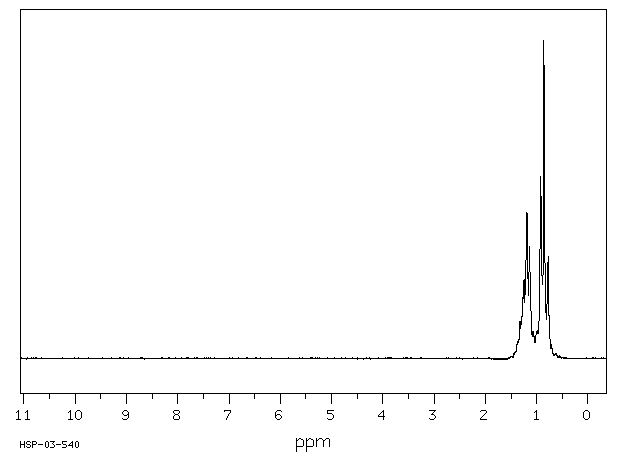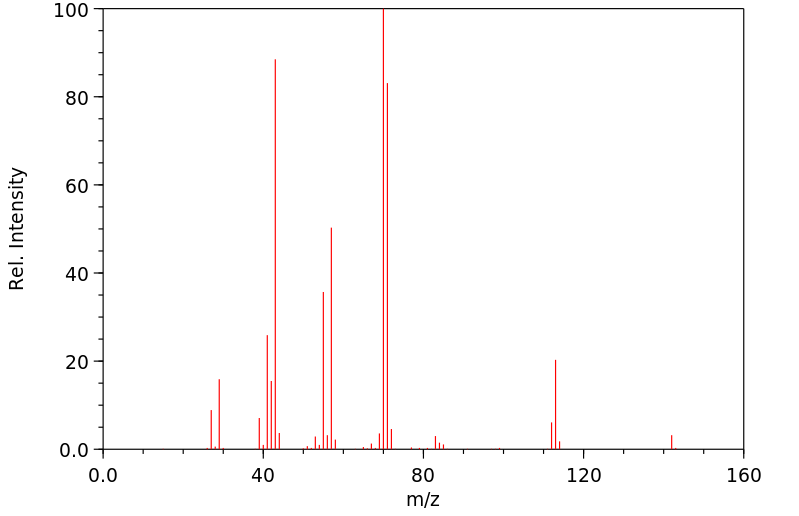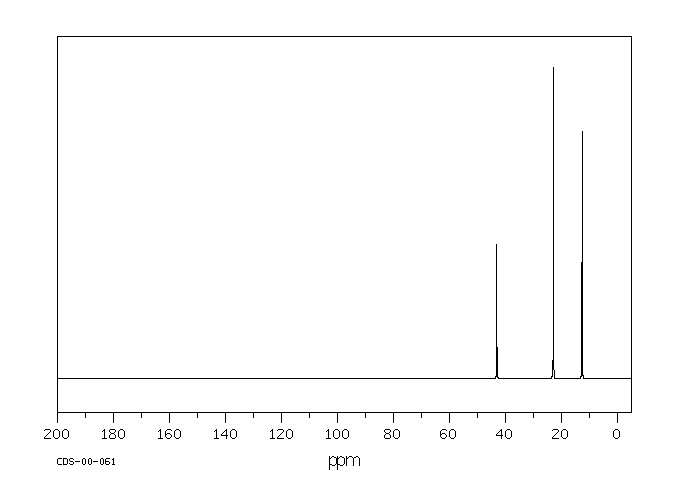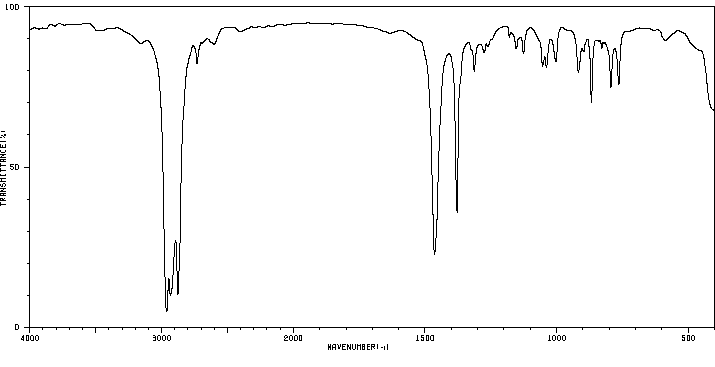3,4-二乙基正己烷 | 19398-77-7
中文名称
3,4-二乙基正己烷
中文别名
3,4-二乙基己烷
英文名称
3,4-diethylhexane
英文别名
3,4-Diaethyl-hexan;3,4-Diethylhexan
CAS
19398-77-7
化学式
C10H22
mdl
MFCD00048666
分子量
142.285
InChiKey
VBZCRMTUDYIWIH-UHFFFAOYSA-N
BEILSTEIN
——
EINECS
——
-
物化性质
-
计算性质
-
ADMET
-
安全信息
-
SDS
-
制备方法与用途
-
上下游信息
-
文献信息
-
表征谱图
-
同类化合物
-
相关功能分类
-
相关结构分类
物化性质
-
熔点:-53.99°C
-
沸点:162 °C
-
密度:0.75
-
保留指数:939.5;937;937;954;946;954;946;937
计算性质
-
辛醇/水分配系数(LogP):5.1
-
重原子数:10
-
可旋转键数:5
-
环数:0.0
-
sp3杂化的碳原子比例:1.0
-
拓扑面积:0
-
氢给体数:0
-
氢受体数:0
安全信息
-
危险等级:3
-
储存条件:室温
SDS
3,4-二乙基己烷
模块 1. 化学品
产品名称: 3,4-Diethylhexane
模块 2. 危险性概述
GHS分类
物理性危害
易燃液体 第3级
健康危害
吸入性危害物质 第1级
环境危害 未分类
GHS标签元素
图标或危害标志
信号词 危险
危险描述 易燃液体和蒸气
若吞咽并进入呼吸道可能致命
防范说明
[预防] 远离热源/火花/明火/热表面。禁烟。
保持容器密闭。
使用防爆的电气/通风/照明设备。采取预防措施以防静电和火花引起的着火。
穿戴防护手套/护目镜/防护面具。
[急救措施] 食入:立即呼叫解毒中心/医生。切勿催吐。
皮肤接触:立即去除/脱掉所有被污染的衣物。用水清洗皮肤/淋浴。
[储存] 存放于通风良好处。保持凉爽。
存放处须加锁。
[废弃处置] 根据当地政府规定把物品/容器交与工业废弃处理机构。
模块 3. 成分/组成信息
单一物质/混和物 单一物质
化学名(中文名): 3,4-二乙基己烷
百分比: >99.0%(GC)
CAS编码: 19398-77-7
3,4-二乙基己烷
模块 3. 成分/组成信息
分子式: C10H22
模块 4. 急救措施
吸入: 将受害者移到新鲜空气处,保持呼吸通畅,休息。若感不适请求医/就诊。
皮肤接触: 立即去除/脱掉所有被污染的衣物。用水清洗皮肤/淋浴。
若皮肤刺激或发生皮疹:求医/就诊。
眼睛接触: 用水小心清洗几分钟。如果方便,易操作,摘除隐形眼镜。继续清洗。
如果眼睛刺激:求医/就诊。
食入: 立即呼叫解毒中心/医生。漱口。切勿引吐。
紧急救助者的防护: 救援者需要穿戴个人防护用品,比如橡胶手套和气密性护目镜。
模块 5. 消防措施
合适的灭火剂: 干粉,泡沫,二氧化碳
不适用的灭火剂: 水(有可能扩大灾情。)
特定方法: 从上风处灭火,根据周围环境选择合适的灭火方法。
非相关人员应该撤离至安全地方。
周围一旦着火:喷水,保持容器冷却。如果安全,消除一切火源。
消防员的特殊防护用具: 灭火时,一定要穿戴个人防护用品。
模块 6. 泄漏应急处理
个人防护措施,防护用具, 使用特殊的个人防护用品(自携式呼吸器)。远离溢出物/泄露处并处在上风处。确保
紧急措施: 足够通风。
泄露区应该用安全带等圈起来,控制非相关人员进入。
环保措施: 防止进入下水道。
控制和清洗的方法和材料: 回收到密闭容器前用干砂或惰性吸收剂吸收泄漏物。一旦大量泄漏,筑堤控制。附着
物或收集物应该根据相关法律法规废弃处置。
副危险性的防护措施 移除所有火源。一旦发生火灾应该准备灭火器。使用防火花工具和防爆设备。
模块 7. 操作处置与储存
处理
技术措施: 在通风良好处进行处理。穿戴合适的防护用具。防止烟雾产生。远离热源/火花/明火
/热表面。禁烟。采取措施防止静电积累。使用防爆设备。处理后彻底清洗双手和脸。
注意事项: 如果可能,使用封闭系统。如果蒸气或浮质产生,使用通风、局部排气。
操作处置注意事项: 避免接触皮肤、眼睛和衣物。
贮存
储存条件: 保持容器密闭。存放于凉爽、阴暗、通风良好处。
存放处须加锁。
远离不相容的材料比如氧化剂存放。
包装材料: 依据法律。
模块 8. 接触控制和个体防护
工程控制: 尽可能安装封闭体系或局部排风系统。同时安装淋浴器和洗眼器。
个人防护用品
呼吸系统防护: 半面罩或全面罩呼吸器,自携式呼吸器(SCBA),供气呼吸器等。依据当地和政府法
规,使用通过政府标准的呼吸器。
手部防护: 防渗手套。
眼睛防护: 护目镜。如果情况需要,佩戴面具。
皮肤和身体防护: 防渗防护服。如果情况需要,穿戴防护靴。
3,4-二乙基己烷
模块 9. 理化特性
液体
外形(20°C):
外观: 透明
颜色: 无色-几乎无色
气味: 无资料
pH: 无数据资料
熔点: 无资料
沸点/沸程 162 °C
闪点: 无资料
爆炸特性
爆炸下限: 无资料
爆炸上限: 无资料
密度: 0.75
溶解度: 无资料
模块 10. 稳定性和反应性
稳定性: 一般情况下稳定。
反应性: 未报道特殊反应性。
须避免接触的物质 氧化剂
危险的分解产物: 一氧化碳, 二氧化碳
模块 11. 毒理学信息
急性毒性: 无资料
对皮肤腐蚀或刺激: 无资料
对眼睛严重损害或刺激: 无资料
生殖细胞变异原性: 无资料
致癌性:
IARC = 无资料
NTP = 无资料
生殖毒性: 无资料
模块 12. 生态学信息
生态毒性:
鱼类: 无资料
甲壳类: 无资料
藻类: 无资料
残留性 / 降解性: 无资料
潜在生物累积 (BCF): 无资料
土壤中移动性
log水分配系数: 无资料
土壤吸收系数 (Koc): 无资料
亨利定律 无资料
constaNT(PaM3/mol):
模块 13. 废弃处置
如果可能,回收处理。请咨询当地管理部门。建议在装有后燃和洗涤装置的化学焚烧炉中焚烧。废弃处置时请遵守
国家、地区和当地的所有法规。
模块 14. 运输信息
联合国分类: 第3类 易燃液体 。
UN编号: 3295
3,4-二乙基己烷
模块 14. 运输信息
正式运输名称: 碳氢化合物, 液体, 不另作详细说明
包装等级: III
模块 15. 法规信息
《危险化学品安全管理条例》(2002年1月26日国务院发布): 针对危险化学品的安全使用、生产、储存、运输、装
卸等方面均作了相应的规定。
模块16 - 其他信息
N/A
模块 1. 化学品
产品名称: 3,4-Diethylhexane
模块 2. 危险性概述
GHS分类
物理性危害
易燃液体 第3级
健康危害
吸入性危害物质 第1级
环境危害 未分类
GHS标签元素
图标或危害标志
信号词 危险
危险描述 易燃液体和蒸气
若吞咽并进入呼吸道可能致命
防范说明
[预防] 远离热源/火花/明火/热表面。禁烟。
保持容器密闭。
使用防爆的电气/通风/照明设备。采取预防措施以防静电和火花引起的着火。
穿戴防护手套/护目镜/防护面具。
[急救措施] 食入:立即呼叫解毒中心/医生。切勿催吐。
皮肤接触:立即去除/脱掉所有被污染的衣物。用水清洗皮肤/淋浴。
[储存] 存放于通风良好处。保持凉爽。
存放处须加锁。
[废弃处置] 根据当地政府规定把物品/容器交与工业废弃处理机构。
模块 3. 成分/组成信息
单一物质/混和物 单一物质
化学名(中文名): 3,4-二乙基己烷
百分比: >99.0%(GC)
CAS编码: 19398-77-7
3,4-二乙基己烷
模块 3. 成分/组成信息
分子式: C10H22
模块 4. 急救措施
吸入: 将受害者移到新鲜空气处,保持呼吸通畅,休息。若感不适请求医/就诊。
皮肤接触: 立即去除/脱掉所有被污染的衣物。用水清洗皮肤/淋浴。
若皮肤刺激或发生皮疹:求医/就诊。
眼睛接触: 用水小心清洗几分钟。如果方便,易操作,摘除隐形眼镜。继续清洗。
如果眼睛刺激:求医/就诊。
食入: 立即呼叫解毒中心/医生。漱口。切勿引吐。
紧急救助者的防护: 救援者需要穿戴个人防护用品,比如橡胶手套和气密性护目镜。
模块 5. 消防措施
合适的灭火剂: 干粉,泡沫,二氧化碳
不适用的灭火剂: 水(有可能扩大灾情。)
特定方法: 从上风处灭火,根据周围环境选择合适的灭火方法。
非相关人员应该撤离至安全地方。
周围一旦着火:喷水,保持容器冷却。如果安全,消除一切火源。
消防员的特殊防护用具: 灭火时,一定要穿戴个人防护用品。
模块 6. 泄漏应急处理
个人防护措施,防护用具, 使用特殊的个人防护用品(自携式呼吸器)。远离溢出物/泄露处并处在上风处。确保
紧急措施: 足够通风。
泄露区应该用安全带等圈起来,控制非相关人员进入。
环保措施: 防止进入下水道。
控制和清洗的方法和材料: 回收到密闭容器前用干砂或惰性吸收剂吸收泄漏物。一旦大量泄漏,筑堤控制。附着
物或收集物应该根据相关法律法规废弃处置。
副危险性的防护措施 移除所有火源。一旦发生火灾应该准备灭火器。使用防火花工具和防爆设备。
模块 7. 操作处置与储存
处理
技术措施: 在通风良好处进行处理。穿戴合适的防护用具。防止烟雾产生。远离热源/火花/明火
/热表面。禁烟。采取措施防止静电积累。使用防爆设备。处理后彻底清洗双手和脸。
注意事项: 如果可能,使用封闭系统。如果蒸气或浮质产生,使用通风、局部排气。
操作处置注意事项: 避免接触皮肤、眼睛和衣物。
贮存
储存条件: 保持容器密闭。存放于凉爽、阴暗、通风良好处。
存放处须加锁。
远离不相容的材料比如氧化剂存放。
包装材料: 依据法律。
模块 8. 接触控制和个体防护
工程控制: 尽可能安装封闭体系或局部排风系统。同时安装淋浴器和洗眼器。
个人防护用品
呼吸系统防护: 半面罩或全面罩呼吸器,自携式呼吸器(SCBA),供气呼吸器等。依据当地和政府法
规,使用通过政府标准的呼吸器。
手部防护: 防渗手套。
眼睛防护: 护目镜。如果情况需要,佩戴面具。
皮肤和身体防护: 防渗防护服。如果情况需要,穿戴防护靴。
3,4-二乙基己烷
模块 9. 理化特性
液体
外形(20°C):
外观: 透明
颜色: 无色-几乎无色
气味: 无资料
pH: 无数据资料
熔点: 无资料
沸点/沸程 162 °C
闪点: 无资料
爆炸特性
爆炸下限: 无资料
爆炸上限: 无资料
密度: 0.75
溶解度: 无资料
模块 10. 稳定性和反应性
稳定性: 一般情况下稳定。
反应性: 未报道特殊反应性。
须避免接触的物质 氧化剂
危险的分解产物: 一氧化碳, 二氧化碳
模块 11. 毒理学信息
急性毒性: 无资料
对皮肤腐蚀或刺激: 无资料
对眼睛严重损害或刺激: 无资料
生殖细胞变异原性: 无资料
致癌性:
IARC = 无资料
NTP = 无资料
生殖毒性: 无资料
模块 12. 生态学信息
生态毒性:
鱼类: 无资料
甲壳类: 无资料
藻类: 无资料
残留性 / 降解性: 无资料
潜在生物累积 (BCF): 无资料
土壤中移动性
log水分配系数: 无资料
土壤吸收系数 (Koc): 无资料
亨利定律 无资料
constaNT(PaM3/mol):
模块 13. 废弃处置
如果可能,回收处理。请咨询当地管理部门。建议在装有后燃和洗涤装置的化学焚烧炉中焚烧。废弃处置时请遵守
国家、地区和当地的所有法规。
模块 14. 运输信息
联合国分类: 第3类 易燃液体 。
UN编号: 3295
3,4-二乙基己烷
模块 14. 运输信息
正式运输名称: 碳氢化合物, 液体, 不另作详细说明
包装等级: III
模块 15. 法规信息
《危险化学品安全管理条例》(2002年1月26日国务院发布): 针对危险化学品的安全使用、生产、储存、运输、装
卸等方面均作了相应的规定。
模块16 - 其他信息
N/A
上下游信息
-
上游原料
中文名称 英文名称 CAS号 化学式 分子量 萘烷 decalin 91-17-8 C10H18 138.253
反应信息
-
作为反应物:参考文献:名称:三种 C10 烷烃的大气化学摘要:已经在 296 ± 2 K 和大气压力下研究了 OH 自由基与 C10-烷烃正癸烷、3,4-二乙基己烷和正丁基环己烷的气相反应的动力学和产物。采用火焰离子化检测器气相色谱法 (GC-FID) 和气相色谱-质谱联用 (GC-MS) 鉴定和定量硝酸烷基酯和羰基产物,采用原位常压电离串联质谱法鉴定和定量,相对于内标、羟基羰基和羟基硝酸盐产品。使用相对速率法,测得 OH 自由基与正癸烷、3,4-二乙基己烷和正丁基环己烷反应的速率常数(以 10-12 cm3 分子-1 s-1 为单位)为 12.5 ± 0.4 ,分别为 7.43 ± 0.48 和 15.8 ± 0.6,其中误差不包括正辛烷参比化合物速率常数的不确定性。鉴定和量化的产品是:2-、3-、4-和 5-硝酸癸酯、羟基...DOI:10.1021/jp010909j
-
作为产物:描述:参考文献:名称:Spaeth, Monatshefte fur Chemie, 1913, vol. 34, p. 1998摘要:DOI:
文献信息
-
Factors Controlling Photochemical Cleavage of the Energetically Unfavorable Ph−Se Bond of Alkyl Phenyl Selenides作者:Akihiko Ouchi、Suyou Liu、Zhong Li、S. Ajaya Kumar、Toshiaki Suzuki、Takeshi Hyugano、Haruo KitaharaDOI:10.1021/jo701447a日期:2007.11.1unexpected amount of Ph−Se bond cleavage (35% in n-hexane at 248 nm) during photolysis. Solvent viscosity, wavelength of light, and the structure of alkyl substituents were the major factors that controlled Ph−Se bond cleavage. The ratio of Ph−Se bond cleavage decreased with increasing solvent viscosity and laser wavelength. The effect of alkyl substituents on the ratio of bond cleavages, Ph−Se/total C−Se研究了烷基苯基硒化物(1)的主要光化学路径,并阐明了由苯基硒化物的光解引起的碳自由基反应获得的产品的化学收率存在较大偏差的原因。的KrF准分子激光photolyses ñ -戊基苯基硒化物(1A),得到1-戊烯(2A),Ñ戊烷(图3a),ñ -癸烷(4A),二戊硒化物(图5a),苯(6),二戊硒(7a中)和主要的光产物二苯二硒化物(7),以及化合物2a,3a,图4a,图5a和7由戊基-硒键断裂,并形成图5a,6,和图7a通过PH-Se键裂解。光产物的选择性表明发生了意外数量的Ph-Se键裂解(n中35%-在248 nm的正己烷中进行光解。溶剂粘度,光波长和烷基取代基的结构是控制Ph-Se键断裂的主要因素。Ph-Se键断裂的比例随溶剂粘度和激光波长的增加而降低。对于五个烷基苯基硒化物,研究了烷基取代基对键裂解率Ph-Se /总C-Se的影响。该比例以戊基> 2-甲基烯丙基>烯丙基> 1-乙基
-
New electrochemical synthesis of ketones from organic halides and carbon monoxide作者:Maïténa Oçafrain、Marguerite Devaud、Michel Troupel、Jacques PérichonDOI:10.1039/c39950002331日期:——The dissolution of a stainless steel anode provides catalytic nickel species which enable the efficient synthesis of ketones by electrolysis of organic halides in DMF in the presence of bipyridine and carbon monoxide.
-
Addition reactions of organometallic reagents to nitrogen trifluoride and enhanced alkyl–alkyl coupling by NF3作者:Randolph K. BelterDOI:10.1016/j.jfluchem.2015.03.013日期:2015.7A survey of the reaction of nitrogen trifluoride (NF3) with various organometallic reagents finds that organomagnesium (Grignard) reagents are the most useful for producing N,N-difluoroaminoalkanes. Alkyl–alkyl coupling is a persistant side reaction. Organolithiums are marginally effective. Organocopper, organozinc reagents undergo primarily alkyl–alkyl coupling catalyzed by the presence of NF3. Organocalcium
-
Making mercury-photosensitized dehydrodimerization into an organic synthetic method. Vapor-pressure selectivity and the behavior of functionalized substrates作者:Stephen H. Brown、Robert H. CrabtreeDOI:10.1021/ja00190a031日期:1989.4
-
Muedas, Cesar A.; Ferguson, Richard R.; Brown, Stephen H., Journal of the American Chemical Society, 1991, vol. 113, # 6, p. 2233 - 2242作者:Muedas, Cesar A.、Ferguson, Richard R.、Brown, Stephen H.、Crabtree, Robert H.DOI:——日期:——
表征谱图
-
氢谱1HNMR
-
质谱MS
-
碳谱13CNMR
-
红外IR
-
拉曼Raman
-
峰位数据
-
峰位匹配
-
表征信息
同类化合物
顺式-1-乙基-3-甲基环己烷
顺式-1-乙基-2-甲基环丙烷
顺式-1,3-二甲基环庚烷
顺式-1,2-二甲基环丙烷
顺式-1,2-二乙基环戊烷
顺式-1,2-二(1-甲基乙基)环丙烷
顺式-1,2-二(1-甲基乙基)环丙烷
顺式,反式,反式-1,2,4-三甲基环己烷
Copper, ethyl-
辛烷-d18
辛基环戊烷
辛基环丙烷
联苯肼酯
联环戊基
羰基双(环茂二烯基)钛
矿油精
癸烷,2,8-二甲基-
癸烷
decyl radical
癸基环戊烷
異十八烷
甲烷-d3
甲烷-d2
甲烷-d1
甲烷-D4
甲烷-3H
甲烷-13C,d4
甲烷-13C
甲烷
甲基自由基
甲基环辛烷
甲基环癸烷
甲基环戊烷
甲基环己烷-Me-d3
甲基环己烷
甲基环十一烷
甲基环丙烷
甲基环丁烷.
甲基丙烷-2-d
环辛烷-D16
环辛烷
环癸烷
环戊烷-D9
环戊烷-D10
环戊烷-13C1
环戊烷,三(2-辛基十二基)-
环戊烷
环戊基甲基自由基
环戊基环庚烷
环戊基环己烷










